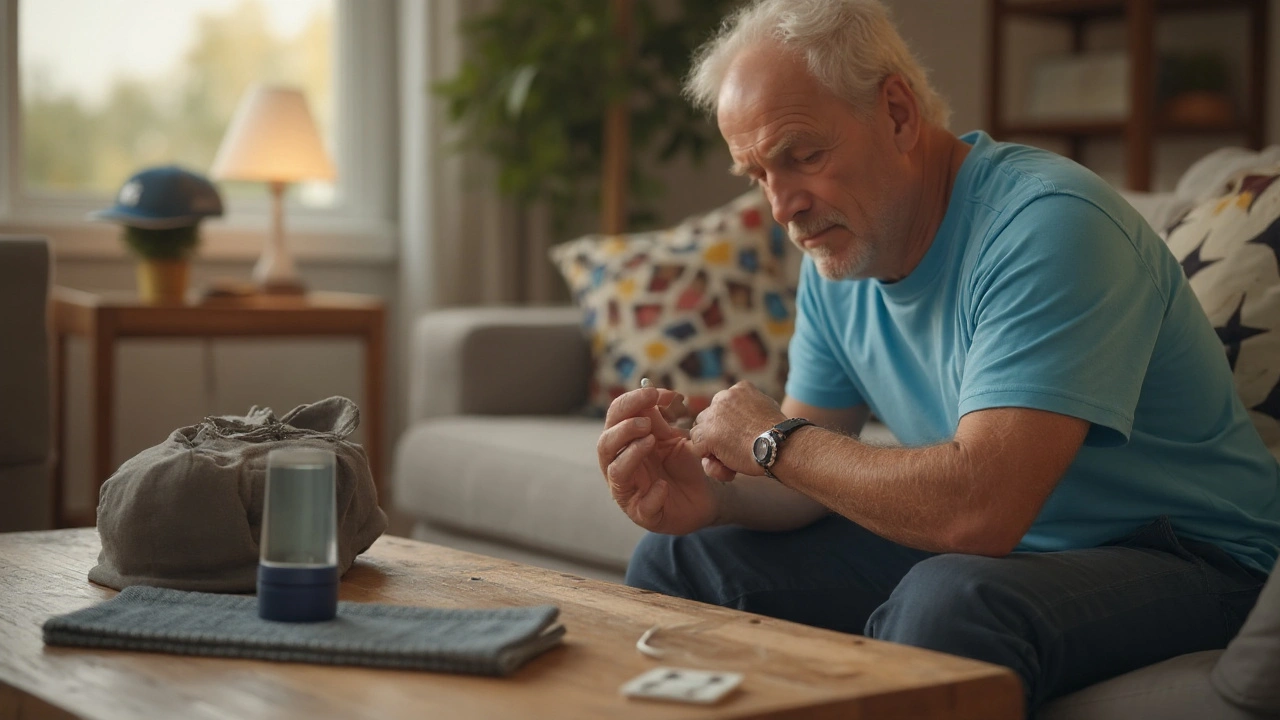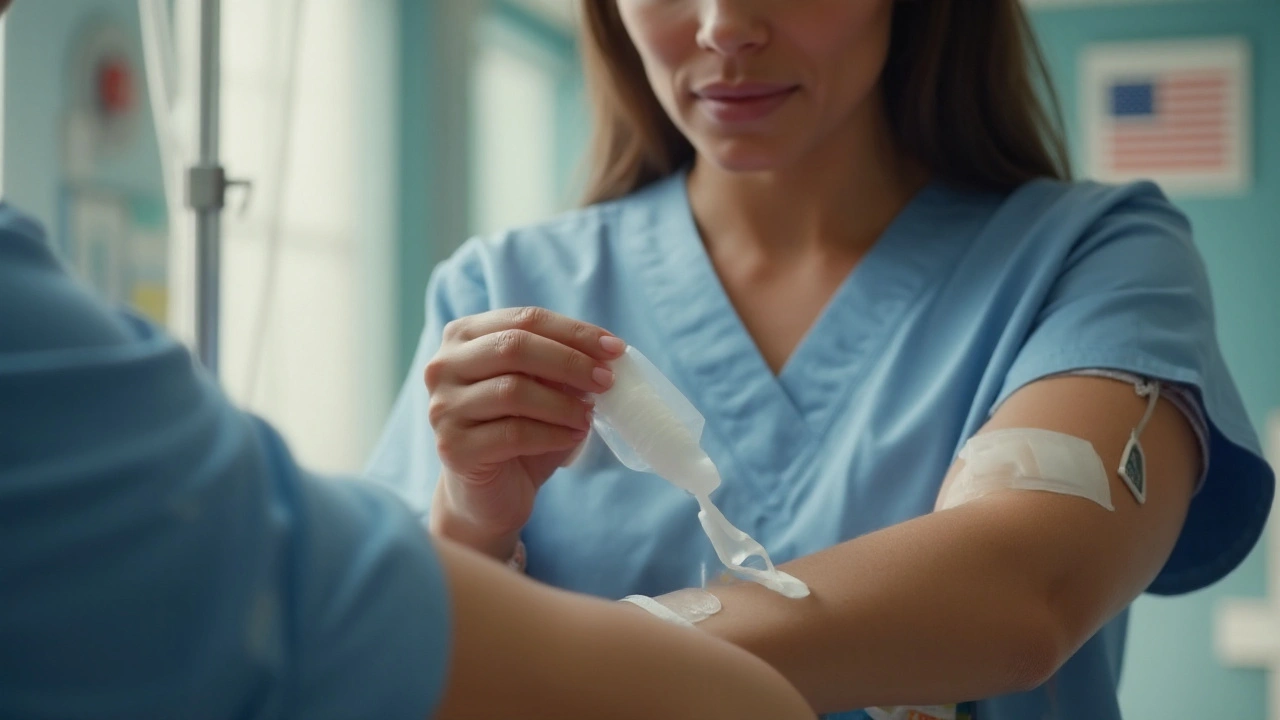Device-Related Skin Chafe Risk Checker
Skin chafe is a type of superficial skin injury caused by friction, shear, or pressure from external objects, often manifesting as redness, rawness, or a burning sensation. When a medical device any instrument, apparatus, or implant used for diagnosis, treatment, or monitoring sits against the body for hours or days, the risk of chafe spikes dramatically. Whether it’s a CPAP mask, an insulin pump, or an orthopedic brace, the skin‑device interface becomes a battlefield if not managed correctly.
What Exactly Triggers Device‑Related Skin Chafe?
Two mechanisms dominate: friction dermatitis inflammation caused by repeated rubbing of the skin against a surface and pressure injury tissue damage resulting from sustained pressure that exceeds capillary perfusion pressure. The former shows up as a bright red, itchy patch; the latter may develop a deeper ulcer if pressure persists.
Key risk factors include:
- Improper fit or oversized straps.
- Moisture accumulation from sweat or wound exudate.
- Sensitive skin, eczema, or recent dermatological treatments.
- Long‑term wear without periodic skin checks.
Prevention: How to Keep the Skin Safe Before Chafe Starts
The best treatment is a preventive routine. Start by assessing the device’s contact points: is the adhesive too aggressive? Are there hard edges?
Apply a skin barrier spray a silicone‑based protective coating that reduces friction and repels moisture to clean, dry skin at least 15 minutes before attaching the device. For patients with very delicate skin, a thin layer of silicone dressing non‑adherent, breathable silicone pad designed to cushion and protect works better than standard adhesive tape.
Other quick wins:
- Trim any loose hair around the attachment zone to avoid tugging.
- Use hypoallergenic, breathable adhesive tapes (e.g., acrylic‑based) instead of aggressive cloth‑backed ones.
- Schedule a 30‑minute skin “break” every 6‑8 hours, if the device allows removal.
Immediate Treatment: What to Do When Chafe Appears
First, remove the device carefully to stop further irritation. Clean the area with mild, pH‑balanced cleanser-no alcohol or harsh antiseptics.
Next, choose a soothing product based on wound depth:
- Superficial redness: apply a thin layer of antiseptic cream e.g., chlorhexidine‑free, zinc‑oxide formula that reduces inflammation while guarding against infection.
- Raw or weeping skin: cover with a non‑adherent dressing such as a hydrocolloid dressing gel‑forming pad that maintains a moist environment and promotes autolytic debridement.
- Persistent friction spots: reinforce with a silicone dressing or a silicone gel sheet to distribute pressure evenly.
Re‑attach the device only after the protective layer has set (usually 10‑15 minutes). If the device must stay on, add an extra silicone dressing between the skin and the device to act as a cushion.

Choosing the Right Dressing: A Quick Comparison
| Dressings | Adhesion Strength | Moisture Management | Typical Use‑Case | Cost (NZD) |
|---|---|---|---|---|
| Silicone dressing | Low‑to‑moderate | Excellent - breathes, reduces shear | Highly sensitive skin, long‑wear devices | 5-8 per sheet |
| Hydrocolloid dressing | Moderate | High - forms a gel that locks moisture | Weeping or ulcer‑prone areas | 4-7 per sheet |
| Silicone gel sheet | Low | Good - smooth surface reduces friction | Pre‑emptive protection for straps or masks | 8-12 per roll |
| Skin barrier spray | None (protective coating) | Very good - repels sweat | Everyday use before device placement | 2-4 per bottle |
For most patients, a layered approach works best: barrier spray → silicone dressing → device. This stack minimizes shear while keeping the skin dry.
Long‑Term Skin Care Plan: Keeping Chafe at Bay
Good habits turn a one‑off irritation into a chronic-free experience. Integrate these steps into a weekly routine:
- Perform a visual skin inspection each shift or at least twice daily.
- Document any redness, heat, or tenderness in a simple log - this aids clinicians in spotting patterns.
- Rotate device placement when possible (e.g., alternate left/right arm for infusion pumps).
- Re‑apply barrier spray after each shower or heavy sweating episode.
- Replace worn‑out adhesive pads every 3-5 days, even if they look intact.
Educating the patient or caregiver is a non‑negotiable part of the plan. Provide a printable checklist that explains when to stop using the device and seek help.
When to Call a Professional
If you notice any of the following, it’s time to involve a clinician:
- Expansion of redness beyond the original border.
- Signs of infection - pus, foul odor, increasing pain.
- Persistent pain despite dressing changes.
- Development of blisters that rupture.
Early referral prevents deeper pressure injuries, which can require costly wound‑care clinics or even surgical debridement.
Connecting the Dots: Related Topics to Explore
Understanding device‑related skin chafe sits inside a broader health‑care safety landscape. After mastering this guide, you may want to read about:
- Pressure injury staging - how clinicians grade severity.
- Choosing the right CPAP mask - fit tips that cut down friction.
- Wearable sensor skin compatibility - trends in low‑adhesion materials.
- Nutrition for skin integrity - protein and zinc’s role in healing.
Each of these topics deepens your ability to keep skin healthy while using life‑supporting devices.

Frequently Asked Questions
Can I use over‑the‑counter ointments for device‑related skin chafe?
Yes, but choose ointments without heavy fragrance or alcohol. Zinc‑oxide creams, petrolatum‑based balms, or silicone‑gel sheets are safe. Avoid antibiotic ointments unless a clinician prescribes them, as they can mask infection signs.
How often should I replace the adhesive padding on my insulin pump?
Even if the adhesive looks okay, replace it every 3‑5 days. Moisture and skin oils degrade tackiness, increasing friction risk.
Is it safe to shave hair around a CPAP mask to reduce chafe?
Shaving can help, but use a clean, electric trimmer to avoid nicked skin. After shaving, apply a barrier spray before wearing the mask.
What’s the difference between a silicone dressing and a silicone gel sheet?
Silicone dressings are usually cut‑to‑size pads with a non‑stick side, ideal for direct contact over a wound. Gel sheets are larger, thin films that spread pressure across a broader area, useful under straps or masks.
Should I keep a skin‑chafe incident in my medical record?
Absolutely. Documenting the episode helps clinicians adjust device settings, change accessories, or refer you to wound‑care specialists before the problem worsens.


Annette van Dijk-Leek
Wow, this guide is super helpful!!! 🎉
Thanks for breaking down the chafe risks step‑by‑step!!!
Can't wait to try the risk checker and protect my skin!!!
Katherine M
Esteemed readers, I commend the thoroughness of this exposition; it reflects an admirable commitment to patient safety. 😊
Bernard Leach
Skin chafe from medical devices is a common but often overlooked problem. It can lead to discomfort and infection if not managed properly. The first step is to assess the device type and wear time. Longer wear increases friction and moisture buildup. Sensitive skin reacts more quickly to pressure points. A proper fit reduces movement and shear forces. Using breathable dressings can wick away sweat. Applying barrier creams before device placement creates a protective layer. Regularly inspect the skin for redness or breakdown. Document any changes in a log to track trends. If irritation appears, adjust the device or alternate positioning. Consider rotating the site to allow healing. Consult a dermatologist if persistent issues arise. Educate caregivers on gentle removal techniques. Maintain the device clean to prevent bacterial colonization. Finally, follow manufacturer guidelines for replacement intervals. These steps collectively minimize chafe and promote skin integrity.
Shelby Larson
Honestly this is basic 101, but apparently many ignore these simple facts. One must never neglect the importance of proper hygiene!!! If you skip barrier creams you are basically inviting infection, it's just common sense. And stop using cheap adhesive patches that cause allergic reactions. People should be more responsible with their health, not rely on luck.
Mark Eaton
Great summary, Bernard! I’d add that keeping a small kit with hypoallergenic wipes and spare padding can make adjustments easier during the day.
Stay proactive and your skin will thank you! 😊
Alfred Benton
While your suggestion appears innocuous, one must consider the hidden agendas of medical supply manufacturers who profit from recurring purchases of such kits. Thus, reliance on proprietary accessories may perpetuate a cycle of dependency engineered by corporate interests.
Susan Cobb
Oh please, here we go again with the usual “buy more stuff” narrative. The real solution is simple: redesign the devices to be skin‑friendly from the outset. Manufacturers love to tout “advanced materials” yet they rarely address basic ergonomics. A bit of genuine innovation would render your accessory kits redundant.
Ivy Himnika
Your critique is noted, Susan. Nevertheless, the interim measures described in the guide remain valuable for patients awaiting next‑generation devices. 😊
Nicole Tillman
Balancing innovation with patient comfort is indeed essential. A collaborative approach between clinicians, engineers, and users can yield designs that respect both functionality and dermatological health. Open dialogue ensures that practical concerns are integrated early in the development process.
Sue Holten
Sure, because everybody loves endless meetings. 🙃
Tammie Foote
Honestly, if you’re not taking skin health seriously, you’re just being negligent. A little effort goes a long way in preventing discomfort and infection.